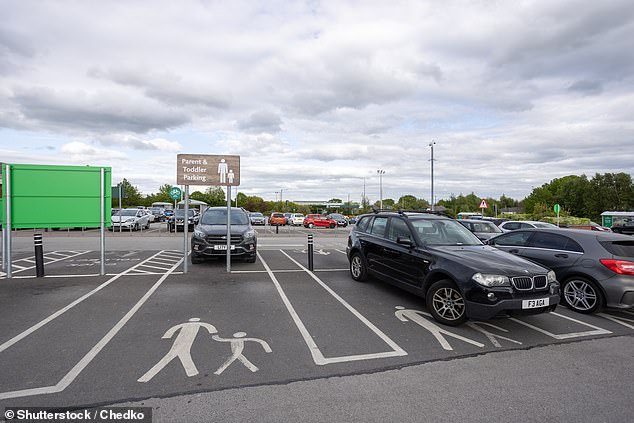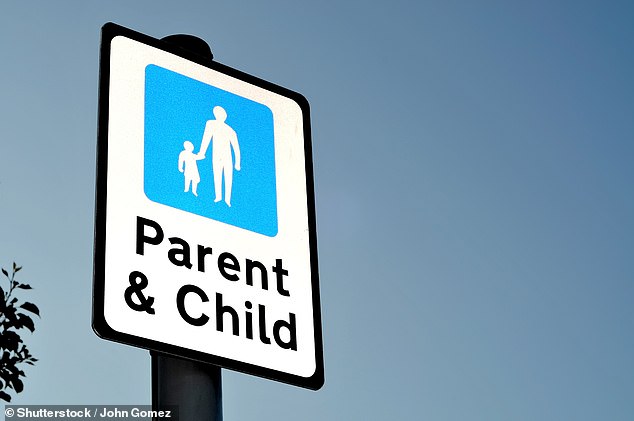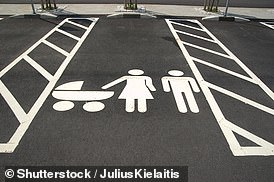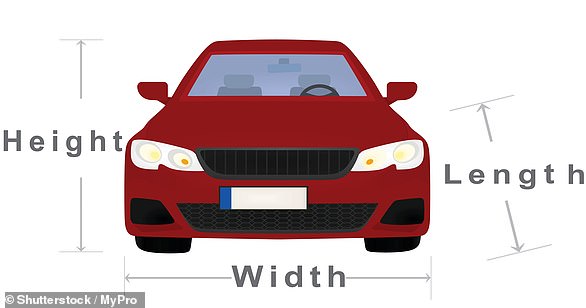Table of Contents
A staggering percentage of motorists have admitted breaking one of the biggest parking rules out there in a shocking new survey.
More than a quarter (28 percent) of drivers surveyed say they use parent-child spaces when they do not have a child in the car with them.
This then explains why almost two-fifths of parents have difficulty finding one of the free spaces when visiting busy car parks, such as supermarkets and shopping centres.
Parent-child parking spaces are generally assigned only to drivers with children under 12 years old and who intend to take them to the stores with them.
A new study by insurer Churchill surveyed 2,000 drivers and another 500 parents of children under 14 years of age and 542 with children from zero to six years of age about their parking habits and experiences.
About 37 percent of those with young children say they have been forced to park in standard-sized parking spaces because all designated spaces were occupied, and faced difficulties because standard parking spaces are too narrow for babies to get in and out easily.
A standard-sized parking space (4.8 meters long and 2.4 meters wide) only leaves about 30 cm to get out of the car, which for those using newborn car seats, which can be removed from the vehicle , is an average of 17 cm smaller.
Parent-child parking spaces not only have the advantage of being located closer to building entrances, but also offer an average of 120 cm of additional space between spaces, giving drivers a total of 150 cm of space to park and get in and out of your vehicle. No danger.
Rules dictate that designated spaces are for the exclusive use of parents or guardians who bring a child under 12 to the store with them.
However, it seems that a surprising number of drivers are willing to abuse the measures in place and park in one without having a child with them.
The report comes after news that five councils are imposing length restrictions on vehicles that can use their public car parks.
Wokingham, South Hams, Broadland and South Norfolk, and West Devon all have a 5 meter restriction, Autocar found in a recent investigation.
Cars including the Audi A8 and Kia’s EV9 electric SUV exceed this restriction and are therefore considered “unparkable”, as are the latest Range Rover and the Tesla Model S and Model X electric vehicles.
Thurrock Council imposes a slightly more lenient length restriction of 5.35 metres, meaning owners of the BMW 7 Series (5,319mm) and Land Rover Defender 130 (5,358mm) will be fined if they use these car parks. managed by the authorities.
There are also height and weight restrictions in these and other car parks managed by the council.

A parent-child space is usually the same width as a conventional parking space (2.4 metres), but with an average of 1.2 meters extra extra space to allow drivers to open the doors and easily access the vehicles. child seats and booster seats.
This follows several reports that parking space dimensions in Britain are outdated, and that 1970s regulations are no longer suitable for the larger vehicles sold in showrooms today. .
Of the 287 local authorities that responded to the motoring magazine’s freedom of information request this year, 91.8 per cent said they have no intention of increasing the size of their municipal parking spaces to accommodate much larger motors. biggest today.
For parents of young children who use rear-facing and/or swivel car seats, the space available in a standard parking space is simply not enough to open the door fully and help safely load children in and out. .
Seven in ten (71 percent) driving parents say they have had difficulty getting their children into their car seat because there was not enough room, and 44 percent said they faced the challenge at least once a month.
Alarmingly, one in four (23 percent) parents with children aged 14 or younger often have to let their children out of the car before they can park in a space due to lack of space.
One in five (18 per cent) parents of children under six have had to leave their car seat in the vehicle because they couldn’t get it out, while another 17 per cent said they had hurt themselves in the past trying to do so. Removing a car seat in a parking lot.
How cars have become wider and longer
| Make a model | Duration in 2018 | Longitude today | Increase |
|---|---|---|---|
| peugeot 208 | 3,475mm | 4,055mm | 580mm |
| Toyota Yaris | 3,495mm | 3,940mm | 445mm |
| Mazda 3 | 4,060mm | 4,460mm | 400mm |
| BMW 7 Series | 5,098mm | 5,391mm | 293mm |
| Mercedes A Class | 4,299mm | 4,419mm | 120mm |
| BMW 2 Series | 4,432mm | 4,537mm | 105mm |
| peugeot 3008 | 4,447mm | 4,542mm | 95mm |
| Mercedes C Class | 4,686mm | 4,751mm | 65mm |
| Toyota Prius | 4,540mm | 4,599mm | 59mm |
| range rover | 4,999mm | 5,052mm | 53mm |
| Volkswagen Tiguan | 4,486mm | 4,539mm | 53mm |
| Source: Autocar |
Scratches and dents caused by parking lot bumps are costly
Drivers with children who cannot use the parent-child compartments are not only inconvenient, but can also be costly.
Being forced to park in tighter, standard-sized spaces can often lead to dings and scratches on both the driver’s vehicle and neighboring vehicles.
This damage is costing UK drivers an average of £223.50 to repair, the insurer calculated.
Nearly one in ten (nine percent) parents surveyed reported damaging their own vehicle while attempting to remove a car seat, and an additional ten percent admitted to damaging the vehicle next to them.
With cases rising as a result of the latest engines being larger than ever, damage claims are another pressure on the average cost of premiums for all drivers.
Nicholas Mantel, director of Churchill Motor Insurance, said: “Parents will be all too familiar with having to drive countless turns around a car park to find an available space for parents and children, only to see that the already limited spaces have been taken up by those without children.
‘The pressure parents face as a result of expanded car and parking spaces that have not been redesigned to accommodate current models particularly affects those with newborn baby seats who need extra space to get babies out of their cars.
“Misuse of parent-child spaces not only inconveniences parents who really need them, but can also result in a hefty parking charge notice.”
Some links in this article may be affiliate links. If you click on them, we may earn a small commission. That helps us fund This Is Money and keep it free to use. We do not write articles to promote products. We do not allow any commercial relationship to affect our editorial independence.




